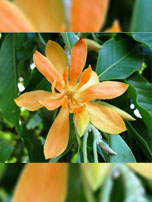Champakah

Botanical Name : Michelia champaca Linn.
Family : Magnoliaceae
Introduction :
Latin name: Michelia = after an Italian botanist; champak = from the Indian name.
There is a believe about this plant, when this plant reaches the height of house/ home (planted near to home ), a person dies in that house. So people usually in Kerala will not take risk about that, so they cut the upper part of the tree. ( )
Names in different Indian languages :
English : Champak, Golden Champa.
Hindi : Champa, Champaka
Kannada : sampige
Malayalam : Champakam, Chempakam
Sanskrit : Champakah
Tamil : Sampagi
Telugu : Champangi, Champangipuvvu
Synonyms :
Champaka, Svarna Champaka, Hemapushpa, Chaampeya
Morphology :
An evergreen tree grows up to 8-12 m height.
Leaves – simple, alternate, lanceolate-oblong, glabrous above
Flower – yellowish orange, white, solitary, axillary, fragrant
Fruit – achene
Distribution & Habitat :
Throughout India
Chemical constituents :
Liriodenine, sesquiterpene lactones, andmicheliolide, polyisoprenoid, beta-sitostero
Properties :
Guna: laghu, ruksha, tikshna;
Rasa: katu, kashaya, madhur;
Vipaka: katu;
Virya: sheeta:
Karma :
Hridya, sugandi vahaka, kushtaghna, vrana hara, rakta pittaghnam, chaksusyam, vrishyam, visadam
bitter, carminative, antispasmodic, demulcent, antiemetic, diuretic , antipyretic, purgative, emmenagogue
Indication :
Kandu, kusta, visha, rakta dosham, mutra krichram , daha
cephalalgia, gout ,rheumatism, head ache
Part used :
Whole plant
Dosage :
Leaf juice 10-15 ml
Powder 2-4 g
Decoction 50-100 ml
Uses :
Local application of flowers is done in headache and burning. Internally it is soothing. hemostatic and antipyretic. The bark is used as a preventive in malarial fever. Flowers are used in dysuria and pyuria.